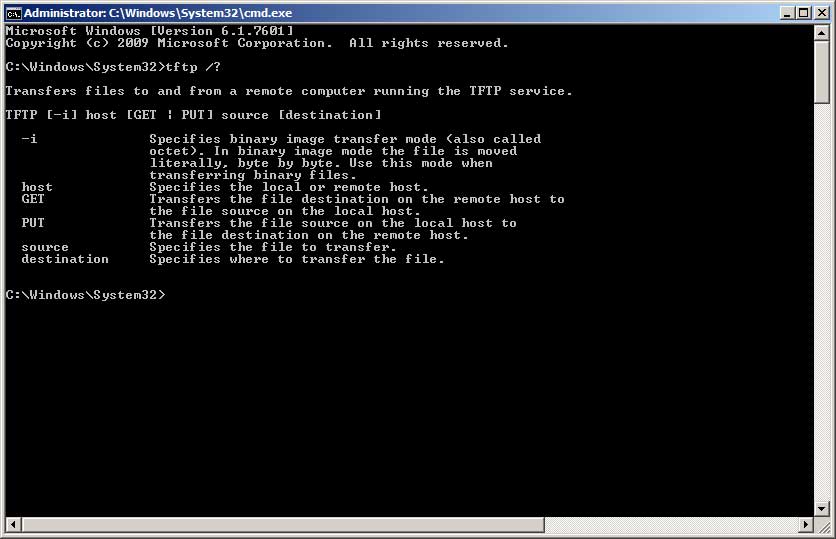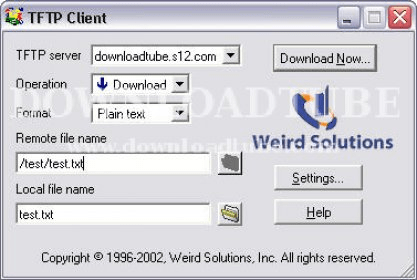

It is also used for network booting by diskless nodes that need booting from the LAN. Today TFTP is commonly used for transferring configuration files and firmware images from and to networking devices. The host can also send a Request to Read (RRQ) then the server sends the data and waits for an acknowledgment. TFTP uses a client/server communication model.Īs as you can see from the message exchange below, the TFTP server sends a block of data and waits for the acknowledgment before sending the next one.Ī host sends a Request to Write (WRQ), the server responds with an Acknowledgement (ACK), so the host sends data.
#TFTP CLIENT EXAMPLE FULL#
These disk-less workstations usually do not have access to the full TCP/IP stack, so they need to obtain configuration information such as DHCP or BOOTP from another server. The original idea of creating TFTP was to provide booting for disk-less computers or workstations that didn’t have enough memory or disk. It provides zero control and has low overhead. TFTP only allows unidirectional file transferring.

Instead of using the full TCP implementation, TFTP relies on the connectionless and simple UDP transport over port 69. It attempts to over-simplify and downsize the functionality of FTP. TFTP (Trivial File Transfer Protocol) is a simple file transferring mechanism developed as a “lighter” version of FTP.
#TFTP CLIENT EXAMPLE HOW TO#
We’ll learn how TFTP works, and how to set it up on the client and server.
#TFTP CLIENT EXAMPLE WINDOWS#
In this step-by-step tutorial, you’ll learn how to set up and configure TFTP on Windows 10. Of course, having no overhead is terrific, but there is a downside it does not provide any encryption and authentication mechanisms.Īlthough TFTP has no built-in security, network admins use it for simple and fast file transfers within LANs.Īnd best of all, it can be used for remote connections by hardening its security with the right server/client software. TFTP is simple on its own and does not need any sophisticated messaging to work. } Part of state machine you suggest looks like this: TFTP_RESULT res = TFTPIsGetReady () īreak Thanks to that I am able to read all file and find end of file and close connection(I verified that on wireshark).Network admins use TFTP Servers every day to transfer images, configuration files, firmware, etc. I modified TFTPGet to have the same interface like in UDPGet so function will looks like this: BOOL TFTPGet(BYTE *v) Get only first letter from file and then end of file. appropriate stack entity to process it. for incoming packet, type of packet and calling This task performs normal stack task including checking TFTPOpenFile(tftpFilePutName, TFTP_FILE_MODE_WRITE) TFTPServerAddr.Val = MY_DEFAULT_TFTP_IP_ADDR_BYTE1 | MY_DEFAULT_TFTP_IP_ADDR_BYTE2<<8ul | MY_DEFAULT_TFTP_IP_ADDR_BYTE3<<16ul | MY_DEFAULT_TFTP_IP_ADDR_BYTE4<<24ul This is how I`m tring to perform the operation:

I use the latest stack but I am not able to put a file from the device using the provided tftpc.c and tftpc.h. In this case (example above) i fetch not all data from the socket at one time/task or? How can i use the TFTPGet() and TFTPIsGetReady functions?Ĭase (TFTP_OK): TFTP_State = TFTP_GET_OK Ĭase (TFTP_END_OF_FILE): TFTP_State = TFTP_EOF

A task cannot fetch part of a packetĭuring one task time and expect to fetch the rest of the It is interested in, it must consume the complete packet This design mandates that once a task detects a packet Time in order for the other sockets to receive their data. Must fetch and discard the receive buffer in one task IfĪ socket receives its data, the owner of that socket "On the receive side, there is only one receive buffer. In the doc an833 i found this information: This function get some data from the udp buffer. Remember that we have flushed this block. If ( oup2._tftpBlockLength.v = TFTP_BLOCK_SIZE_MSB ) To reduce code, MSB is compared for 0x02 (of 0x200 = 512). Check to see if entire data block is fetched. I fix some errors and change some functions. In the stack version 3.75 and 4.02 the client works not out of the box.


 0 kommentar(er)
0 kommentar(er)
